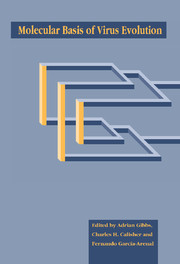Book contents
- Frontmatter
- Contents
- List of contributors
- Editors' preface
- Conference participants
- 1 Introduction and guide
- Part I The impact of viral diseases
- 2 Classical studies of virus evolution
- 3 The evolution of virus diseases: their emergence, epidemicity and control
- Part II Origins of viruses and their genes
- Part III Sources of virus variation
- Part IV Molecular interactions of viruses and their hosts
- Part V Viruses, hosts and populations
- Part VI Case studies of viral taxa; their systematics and evolution
- Part VII Techniques for viral systematics
- Index
2 - Classical studies of virus evolution
Published online by Cambridge University Press: 04 May 2010
- Frontmatter
- Contents
- List of contributors
- Editors' preface
- Conference participants
- 1 Introduction and guide
- Part I The impact of viral diseases
- 2 Classical studies of virus evolution
- 3 The evolution of virus diseases: their emergence, epidemicity and control
- Part II Origins of viruses and their genes
- Part III Sources of virus variation
- Part IV Molecular interactions of viruses and their hosts
- Part V Viruses, hosts and populations
- Part VI Case studies of viral taxa; their systematics and evolution
- Part VII Techniques for viral systematics
- Index
Summary
‘Classical’ has connotations of ‘ancient’, but for this book the word relates to studies on virus evolution dating from the time before the sequencing of viral genomes became a way of life for evolutionary virologists. Classical ideas on the origins of viruses were pure speculation and are not worth pursuing further; it was suggested that viruses had arisen either from host cell components in some unknown way, or that some of the more complex viruses may have evolved by progressive degeneration along the sequence bacterium, mycoplasma, rickettsia, chlamydia, poxvirus. Since the focus of this book is the role of molecular biology in understanding viral evolution, I have selected as examples the only two viruses that were discussed in an evolutionary context in books on animal virology published before the emergence of recombinant DNA technology in the early 1970s, namely influenza A virus and myxoma virus (Burnet, 1955, 1960; Andrewes, 1967; Fenner et al., 1974).
Early studies on the evolution of influenza A virus
Here I describe our knowledge of the evolution of influenza viruses as it appeared in 1975, when the only methods of study were serology and peptide mapping of selected proteins. Chapter 34 takes over from that time and tells how molecular biological methods have expanded our understanding of the evolution of these very interesting viruses.
Structure of the virion
First, a little background is needed. There are three species of influenza virus, A, B, and C, each of which can produce respiratory disease in humans.
- Type
- Chapter
- Information
- Molecular Basis of Virus Evolution , pp. 13 - 30Publisher: Cambridge University PressPrint publication year: 1995
- 1
- Cited by



